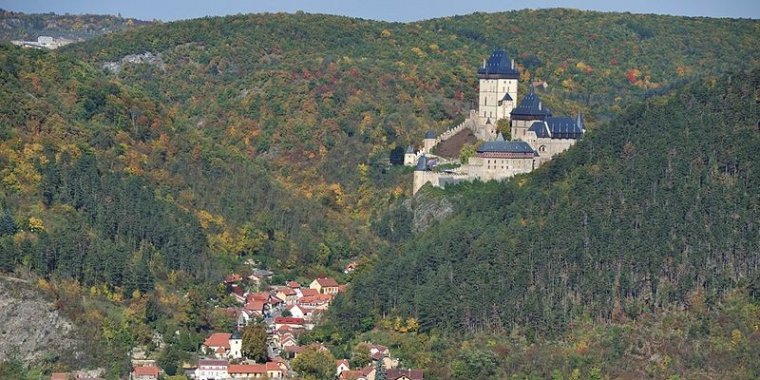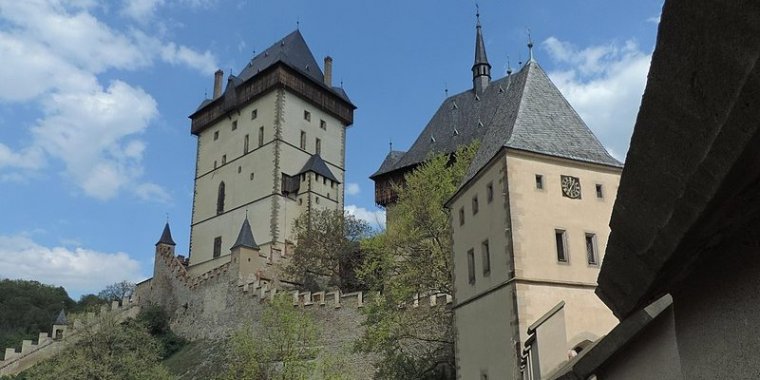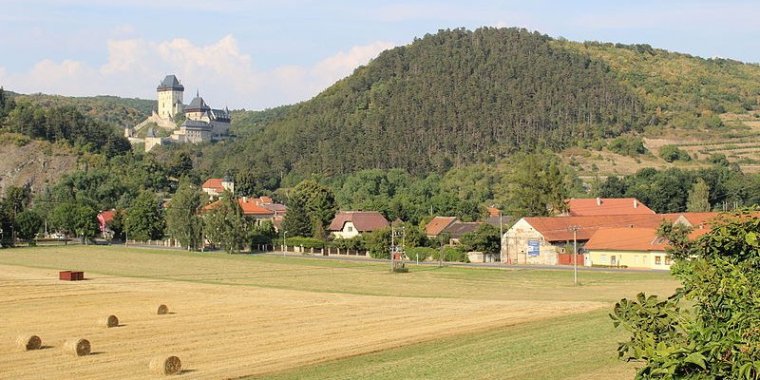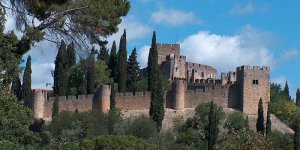| Published in Destinations |
Karlštejn, Czech Republic
Construction of the castle was completed in 1365 under the reign of Holy Roman Emperor Charles IV. There is a national forest around the castle with some very nice hiking. Nearby in the village of Svatý Jan Pod Skalou you can visit a beautiful monastery including the 'holy cave' that it was built upon.
Get in
From Prague you can take a commuter train (line S7) from the main station (Hlavní nádraží) or the Smíchov station. Journey takes 40 minutes and return ticket from the main station to Karlštejn station costs 99Kč. If you travel in a group of two people or more, ask for a group discount. First person in a group pays CZK 99 as usual, but second pays 69Kč, and each extra person pays only 50Kč.
Most of the time, trains run every half hour, you can pick them up either in Srbsko, Beroun, or in Karlštejn. If you are in Svatý Jan Pod Skalou, you can hike to Srbsko (8 km), Beroun (5,5 km), take a taxi to the Beroun train station, or take a direct bus to Prague (every two hours on weekdays, four a day on weekend). Check the bus schedule at the bus stop or ask at the restaurant.
Coming by car is also an option, a reasonably sized car parking is available at the river.
Another option is doing a relatively flat bicycle track from Prague, alongside the Berounka river. Start at Zbraslav, from there follow the bicycle route 8100 into Černošice, and route 3 afterwards.
Get around
Everything is within walking distance. When you arrive at Karlštejn you cannot actually see the castle, turn right at the station exit, walk 200 meters then turn left over a bridge into the village, or just follow the flow of tourists and you'll get there. The village starts about 500 meters from the train stop, the castle is a short (but slightly tiring) half kilometer hike up a large hill.
For those who don't want to walk up the hill to the castle it is possible to take a taxi (100Kč per way) or a horse-drawn carriage (150Kč per way) from the car park.
What to See in Karlštejn
• The castle. All of the tourists aside, the 1 Karlštejn castle itself is really impressive. Once you arrive at the castle you can enter within the walls for free but access to the inside of the castle requires paying for a guided tour (220 Kč). There are several tours in different languages during the day. Call in advance to determine the exact times. There is also a 70-minute tour option that visits other rooms, including the Chapel of the Holy Cross, but remember to make a reservation. You can buy tickets online.
Unless you are particularly interested in Ancient Holy Roman Empire history you may want to take only the 50-minute tour, or limit yourself to walking on the castle parapets, enjoying the view and reading the outdoor information boards with the castle's history. This will give you more time for hiking to Svatý Jan Pod Skalou which is a bit more authentic Czech experience.
The castle is closed on all Mondays, even during the high season.
• Svatý Jan Pod Skalou. The name of this monastery translates to "Saint John under the rock", which is quite an apt description for the monastery. The monastery was built on a natural spring at the base of a 100 m sheer cliff (the cliff being crowned with a large cross). Prior to the monastery being built a "saintly" hermit took up residence in a deep cave next to the spring where he "fought great battles with satanic spirits." The monastery is open daily, donations are requested at the door (but not obligatory). Don't miss the little door directly opposite from the main entrance, this is the entrance to the 'holy' cave.
The cave contains five large rooms, all of which have been modified for religious purposes. One part becoming a crypt, another having a large altar, others for saintly relics, etc. Before entering pick up one of the laminated explanation papers laid out on the pews next to the door. They are done in all of the major European languages and explain what each room in the cave was use for. Outside the monastery if you look around you'll find the natural spring located in a small grotto just around the corner from the Monastery entrance. The spring water is drinkable and quite tasty.
What to Do in Karlštejn
• Hiking. A trip to Karlštejn starts with a trip to the castle, which was the seat of Holy Roman Emperor Charles IV. The 50-minute tour is delightful, and well worth the time. There is a lovely and picturesque hike available to the Svatý Jan Pod Skalou monastery through the Český Kras protected area (Bohemian Karst or Czech Karst in English). While at times rugged (it actually is 12 km, and not the 8 km marked), it is more than doable for those who are in good shape and have the proper equipment. It begins at the castle walls (look for the red markings near the trailhead at the castle walls).
A caveat: the hike is likely to be too challenging if you are not in good physical condition and lack proper hiking shoes. Specifically, the path meanders through forest, stream, several steep uphills, some slippery rocks and tricky downhills. There are numerous locations during the hike where you have no cellular service.
Another thing to remember is that the path markings while clear after some experience reading them, first appear rudimentary, so always follow the red markings on the trees. The green trail marks also are fine--they track the red markings until approximately 1km before the monastery, and there is a clear sign marking the turnoff to the monastery.
Once you arrive at the monastery (which closes at 4 PM), you have the choice to take another hike to the town of Srbsko or to Beroun, where you catch the train back to Prague. The hike from the monastery to Srbsko actually is 8km, and not 5km, as indicated. The yellow signs purportedly indicating the path to Srbsko are nearly impossible to find. For the hike from the monastery to Beroun train station just follow the same red marks, it's 5,5 km and easy to find. There are two train stations in Beroun. The red marks lead you to the right one to take the train back to Prague.
Alternatively, if you call a taxi from the local restaurant in Svatý Jan Pod Skalou (75 meters from the monastery, on the right), this is a 12km hike, punctuated by round-trip train rides and taxis. If you choose to hike to Srbsko, be prepared for an all day, 20 km hike. If you do decide to hike to Srbsko (and assuming you can find the yellow signs), the Srbsko train station is directly across the blue bridge. There is no place to purchase tickets. Those can be purchased on the train, however. The town of Beroun is closer to the monastery and larger; tickets can be bought at the train station here.
• Rock climbing. Some of the best rock climbing near Prague is in Srbsko and Svatý Jan Pod Skalou.
• Abandoned quarries. For the more adventurous, there are also several open pit limestone quarries, called Malá Amerika/Velká Amerika ("Little America"/"Big America"). They're filled up with water and have become a popular place for Czechs to go swimming. The pits are connected by a extensive system of shafts and galleries, waiting to your exploration. The quarries are a bit difficult to find but if you ask around and have a good map you should be able to find them. They are officially closed to the public, because access to them is somewhat dangerous.
Buy
Karlštejn has shops selling Czech garnet, Bohemian crystal, tasteless t-shirts, wares from local blacksmiths, etc.
If you want to buy food for hiking there is a small village-style grocery store about a third the way up the hill. It is on your left (heading up the hill). Don't buy any food, drinks or water from the small shops at the base of the village. They have extremely over inflated prices, a bottle of water costs 45kč (normal price is 12kč).
Eat and Drink
Around the castle there are plenty of expensive restaurants but you'd be best to avoid them. If you are not planning on hiking and want to eat in Karlštejn, your best option is to get on the red marked trail (trail head is right next to the entrance in the castle walls at the top of the hill, marked with a red and white square marker usually painted on a tree or wall), walk down the trail (going down hill) about 300 meters, you'll come to a road on which there is a nice authentic Czech pub.
• Krcma u Ezopa, Next to the train station. Very nice authentic Czech pub with great food at low prices and very good service with a smile.
In Svatý Jan Pod Skalou there is a very nice pub 75 meters from the monastery. The prices are reasonable, the beer is good and the food is very Czech.
Sleep
If you want to camp, there is a very crowded campsite near Karlštejn but it is not recommended that you stay here. If you hop on the train and go one stop further down there is a very nice campsite in the village of Srbsko (about 5km from Karlštejn) with a little outdoor restaurant serving traditional 'klobasa' and other Czech camping foods. You can also walk to the campsite along the Berounka river.
Go next
• Beroun
• Křivoklat
• Prague (Wikivoyage)
Karlštejn in Pictures
YOU MAY ALSO LIKE

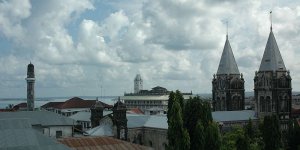
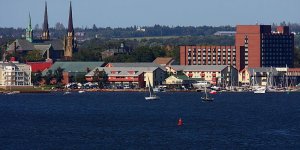

 If you own or manage a travel-related business such as a hotel, a bed-and-breakfast, a restaurant, a pub or a cafeteria, you can create a web page for your business for free on Titi Tudorancea Travel Info. » |

